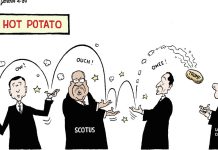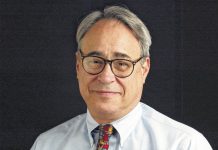By Harry McCawley
It was only here for 20 minutes, but on a bitterly cold November night in 1915, Columbus threw one of the biggest parties in its history. At the same time it also helped the United States and its allies win World War I.
The unlikely event along a railroad siding in downtown Columbus was part of a nationwide tour of the world-famous Liberty Bell, which was chronicled in the April issue of Smithsonian magazine.
The bell, recognized primarily by a deep vertical crack that ran almost from top to bottom, had first gained fame as a symbol of the American Revolution and for decades after the nation’s quest for independence had been achieved was displayed as a badge of honor in Philadelphia’s Independence Hall.
City leaders were reluctant to let it leave even for brief exhibitions, and by 1915 it had only been taken out of its home six times. But that year the United States was being drawn into a global conflict in Europe, a war most Americans wanted no part of but one that leaders like President Woodrow Wilson viewed as inevitable.
[sc:text-divider text-divider-title=”Story continues below gallery” ]
Seeking to infuse a spirit of patriotism among citizens and prepare them for entry into what would become World War I, Wilson and other leading Americans put together a nationwide train tour of the bell. According to the Smithsonian article, it made 275 appearances in cities and towns spanning the East and West coasts and the borders with Mexico and Canada.
Most of the visits were to densely populated metropolitan areas where it was put on display for several days to accommodate the large crowds. But in between those metropolitan areas were dozens of towns and hamlets that might not have had much in the way of residents but were on the bell’s route.
One of those towns was Columbus, which had a railroad depot and a population of 8,813. It also was midway between Indianapolis and Louisville, where major exhibitions were planned.
City leaders learned early in September 1915 that the Liberty Bell train was scheduled to pass through the city in mid-November. Wasting no time, Mayor Karl Volland put together several planning committees with the goal of staging a mammoth welcome party.
That was a pretty tall order. Indianapolis, for instance, had a population of 233,650, and Louisville wasn’t far behind. Columbus with 8,813 had to take what it could get in terms of time and length of visit.
City leaders were told the train would arrive in Columbus at 2:20 a.m. on Nov. 22, and anyone in town wanting to get a glimpse of the bell had 10 minutes before it pulled out from the depot that was located in the area where Cummins corporate headquarters now stands.
Given such restraints, organizers focused much of their attention on events leading up to the actual arrival. As an incentive for residents to stay awake for the arrival, restaurants remained open well past midnight, and three of the city’s movie theaters (the Crump, Lyric and Crystal) offered post-midnight showings that resulted in packed houses.
According to The Evening Republican newspaper, “There were plenty of indications of the spirit of 1776 (the year the Declaration of Independence was signed) and a few indications here and there of spiritus frumenti.”
Despite enticements such as movies, late dinners and distilled spirits, the place to be on Nov. 22, 1915, was City Hall, the setting for the official Liberty Bell welcoming party. The program included a number of speeches by local residents whose names are still recognized in Columbus history several generations later.
The opening address was by the Rev. Z.T. Sweeney, of the Irwin Sweeney Miller family, who spoke at length about certain changes that had been or would be achieved since the Liberty Bell was rung. Specifically he hailed the ending of slavery during the Civil War and predicted correctly that women would be given emancipation within a decade. No doubt with an eye on some who might have prepared for the cold of the night with “spiritus frumenti,” he also suggested it wouldn’t be too long before the “shackles had been struck from those who are slaves to drink and that nationwide prohibition would be a reality.”
He was right on his two predictions, although Prohibition proved to be short-lived.
To keep the crowd awake, Louis Richard, a train engineer by profession but who was best known for the local cartoons he sketched for The Republican (some of his works accompany this article), gave a demonstration of cartooning, and two high school students gave short talks about patriotism. One of them was Yandell Cline, who later would become an editor of The Evening Republican and from there an executive with Arvin Industries.
The ending of the City Hall event was scheduled to give the crowd time to parade from Fifth and Franklin streets to the depot at Seventh and Jackson streets prior to the train’s arrival at 2:20 a.m. In the forefront of the marchers were members of the Columbus City Band.
Upon arrival at the depot, the crowd was split into two groups, lining up in rows of three on one side of the exhibit car and four on the other. They moved briskly past the bell, which was well-illuminated and clearly exposed on both sides, but there were so many that organizers agreed to delay their departure by 10 minutes, allotting the city of Columbus a total of 20 minutes of Liberty Bell viewing.
By the time the last local resident had gotten a glimpse of the iconic bell, officials estimated that 5,000 others had shared in the experience.
The 1915 Liberty Bell tour was only a preamble for what was to come. The United States did, indeed, enter the war in 1917, but it was woefully short of the money needed for such a commitment. It was estimated that $2 billion (about $40 billion today) would be needed for the war effort, and the money had to be raised in a short, six-week time period.
Building on the overwhelming success of the 1915 Liberty Bell tour, government organizers used the bell as a centerpiece in a series of war bond drives in which citizens were asked to purchase war bonds for the American effort. In all, four bond drives collected more than $17 billion by 1917, far and above the $2 billion estimate made two years earlier.
That success could have been foretold on a cold November night in a small town in southern Indiana where more than half its population would turn out at 2:20 in the morning to see a bell with a long crack running down its side.
Harry McCawley is the former associate editor of The Republic. He can be reached at [email protected].




